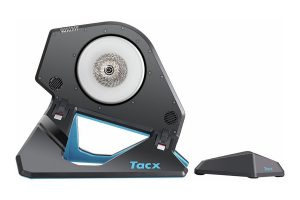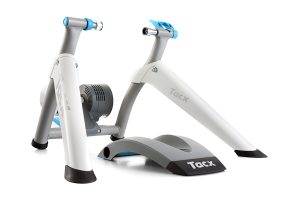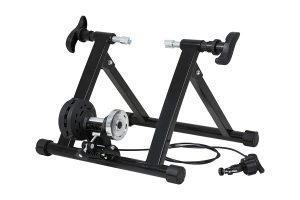With many countries in lockdown mode, demand for bike trainers (sometimes called turbo trainers) is skyrocketing, especially during the winter months. Rather than riding outdoors in the cold, wet weather or with limited distance and time, bike trainers are a very useful indoor cycling tool to have at home.
Some of the commonly asked questions are,
- Which model should I get?
- Should I get a smart trainer?
You’re on the right page.
How We Pick Bike Trainers
Choosing the right bike trainer can sometimes be daunting. For beginners, these training tools can quickly get very complicated with all the advanced features such as ERG, SIM, or Resistance modes.
We begin by focusing on established models on the market from big names such as Wahoo, Tacx, and Elite among others. We know that they have a good track record of producing high-quality trainers in the past. And based on the collective experience of our team which is made up of very experienced and everyday cyclists, we applied the following criteria to decide makes it into our list.
- Type of Trainers. Direct drive models have a much better road feel compared to wheels-on models. However, they do come with a higher price tag. If you’re within a tight budget, we picked some of the better wheels-on trainers too.
- Smart vs Non-smart Trainers. We covered a range of models from non-smart (dumb) to smart and interactive ones that allow you to connect to virtual riding apps such as Zwift.
- Acceptable Noise Levels. No one wants to wake the entire house or neighbors up at 6am while riding their trainers. Hence, we stay away from fan-based resistance models as they’re the loudest (very).
- Bike Compatibility. We strive to pick models that are compatible with a wide range of bikes be it disc or rim brakes, road or mountain bikes. They can easily fit other bikes using the various adaptors that come in the box.
- Varying Price Range. Not everyone has the luxury to splash $1,000+. We picked models from low (~$300) to mid-tier ($300 – $800 and top-tier ($900+).
You can read more about this in our bike trainer buying guide here.
A Quick Glance : Our Favorite Indoor Bike Trainers
Interactive Trainers for Zwift
These are models that offer the most immersive indoor riding experience. They provide the best road-like feel as the resistance dynamically adjusts itself according to the virtual terrains you’re riding in.
Tacx Neo 2T
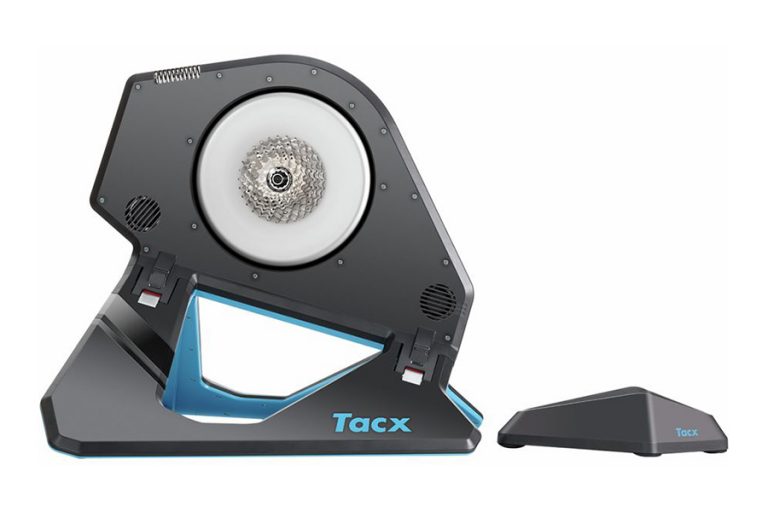
The Tacx Neo 2T is by far the quietest smart trainer on the market.
Its revolutionary design over its predecessor, the Tacx Neo 2 allows for it to run wireless or hooked up to a power source, making it perfect for those on the go. This is for those that just became a parent, those that live in a small apartment with thin walls, or those that just can’t stand the noise of indoor trainers.
Although it weighs 47 lbs., it’s a breeze to store due to its compact frame design and foldability. It can quickly connect to Apple and Android devices through Bluetooth. It’s a direct drive smart trainer that allows for an excellent ride feel that even includes dynamic inertia and descent simulation.
The Tacx Neo 2 is ideal for those that absolutely must have peace and quiet during their training rides while also retaining the features that make for an excellent ride.
- Pros : Very quiet. Simulates up to 25% max gradient.
- Cons : Max power limited to 1,600 watts.
Wahoo Kickr Core
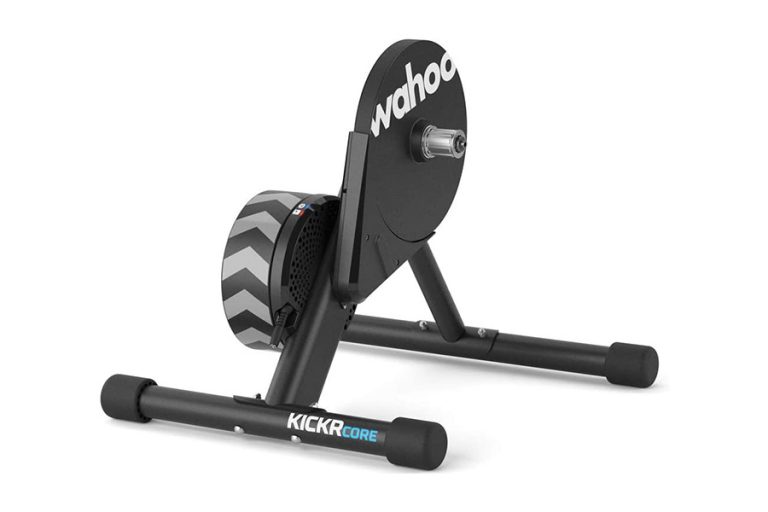
Wahoo’s latest iteration of its Kickr lineup gives you the smart capability you want at an affordable price.
The Wahoo Kickr Core works with apps like Zwift, The Sufferfest, and TrainerRoad. It seeks to be a more affordable option than the standard Wahoo Kickr. It accomplishes this by not including a cassette, which shaves off significant costs.
It is lighter and more compact. This does mean that the flywheel on the Core is lighter, so you’ll have to settle for a max of 16% gradient with the Core vs. the Kickr’s 20%. This also means that the max power output for the Core is 1,800 watts vs. 2,200 watts for the standard Kickr.
- Pros : Excellent value for money vs features.
- Cons : Max power limited to 1,600 watts.
Elite Drivo 2
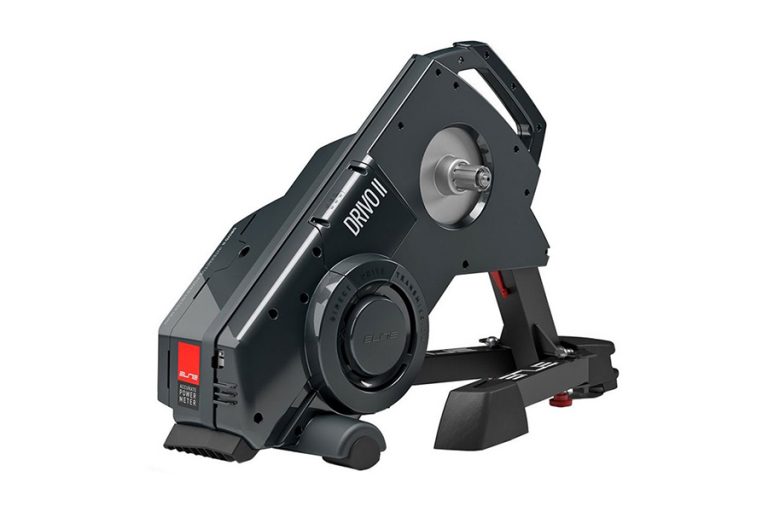
For the premium price tag, you’ll get a reasonably quiet ride and an unusually realistic ride.
While Elite’s original Drivo already had a solid reputation for stability and responsiveness, the Drive 2 takes these qualities and improves on them by a significant margin.
Coming with a good assortment of standard extras like a cadence monitor and various thru-axle adapters, the setup is relatively smooth and simple. As soon as it’s assembled, mounting your bike will quickly get you into a very responsive and realistic training session, perfectly complemented by your favorite virtual training software such as Zwift, Trainerroad, or Rouvy.
- Pros : Power accuracy within +/- 0.5%. Improves response times over its predecessor.
- Cons :Cassette not included.
Wahoo Kickr
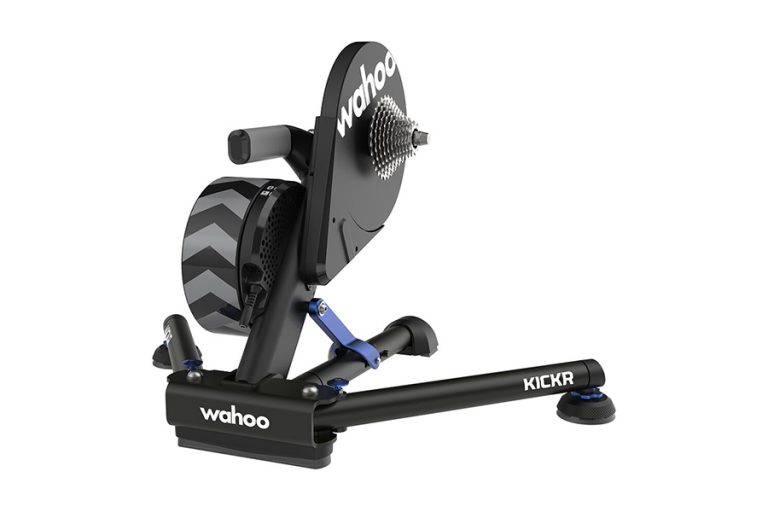
When it comes to the best overall trainer to connect to Zwift, most other models pale in comparison to the Wahoo Kickr.
The Wahoo Kickr offers the ultimate indoor bike riding experience. It provides a plethora of options such as Kickr Climb, a grade simulator, and even a headwind simulator, known as Kickr Headwind. Its sensors guarantee that your riding experience is as close to the real deal as possible. It boasts a wide range of connectivity through Bluetooth Smart, ANT+, and ANT+ FE-C.
The Wahoo Kickr offers a near-silent design, perfect for those who don’t want to hear the noise produced in wind, magnetic, or fluid resistance trainers.
This is the ideal for those who don’t mind a hefty price tag and desire the ultimate riding experience. But if you’re slightly tight on budget, consider the Kickr Core.
- Pros : Very realistic ride feel and simulates up to 2,000 watts.
- Cons : No cadence sensing capabilities.
Elite Direto X
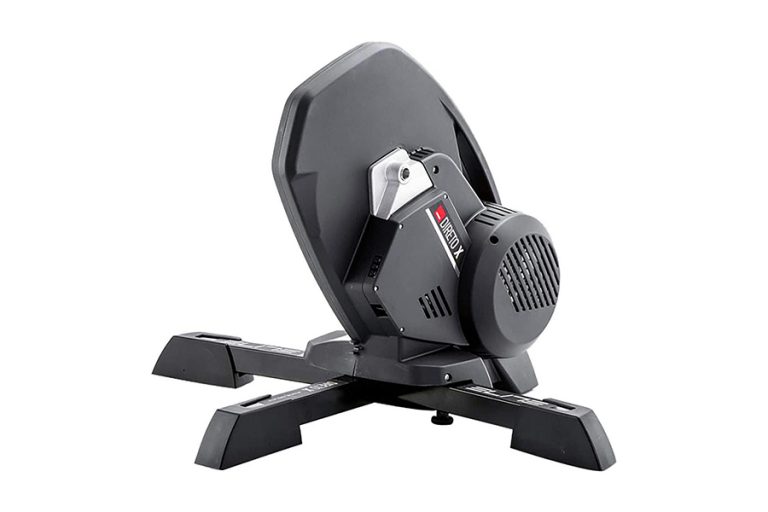
This is the suited to those who want the flexibility of high-end models, but also want to save a bit of money.
The Elite Direto X boasts an integrated Optical Torque Sensor to achieve accurate power measurements and power readings. A pedal stroke analysis option is available to hone in on the perfect spin. It comes with in-house training software that records your training efforts.
Just like other high-end models, the Elite Direto X offers Bluetooth Smart and ANT+ FE-C capabilities. It’s a direct drive trainer so you can be sure that you won’t be wearing out any of your road bike tires.
- Pros : Very stable base for powerful sprint intervals with maximum power up to 2,100 watts.
- Cons : Slower response times compared to peers.
Smart Trainer Picks
These are smart because they come with ANT+ and/or Bluetooth connectivity in which you can then connect to online training apps such as Zwift. The main difference is that resistance on these trainers are controlled manually.
Tacx Flow
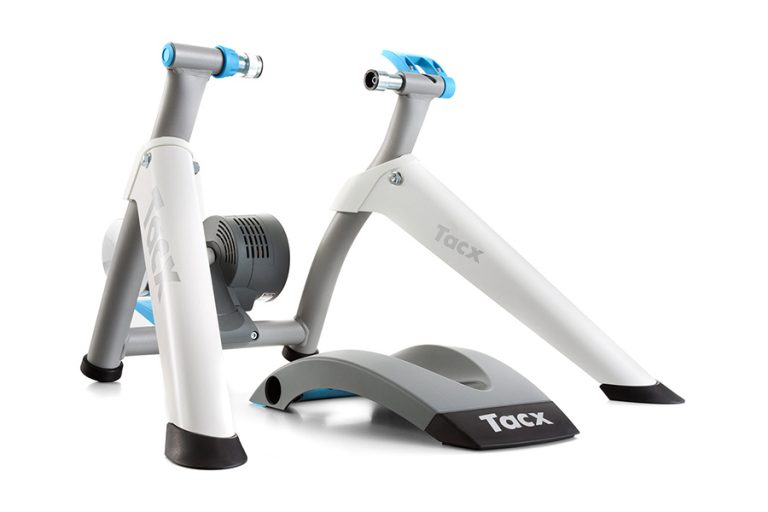
Updated for wireless transmission of speed, cadence and power, the TacxFlow works easily with training apps through the inclusion of Bluetooth and ANT+ connectivity.
Designed as much for ease as for versatility, itswheel on design saves you time and effort with tricky mounting and dismounting for your back wheel. To help you be considerate towards your neighbors, an elastogel core is built into the roller, reducing noise and vibration without waking the whole street.
Finally, the Tacx Flow’s electric brake can simulate incline resistance of up to 6%, and the 3.5lbs flywheel creates a realistic impression of outdoor inertia.
- Pros : Compatible with Zwift and TrainerRoad with a full suite of wireless connectivity options.
- Cons : Resistance unit may require periodic adjustments.
Kinetic Rock and Roll
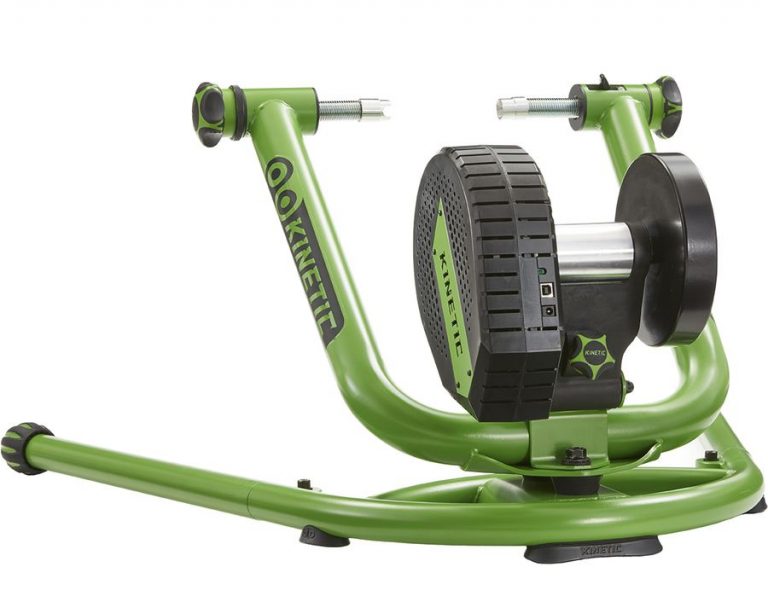
Simulation is a huge factor when it comes to indoor trainers. You want the it to feel, as much as possible, like the real thing. So, when you get up out of the saddle to climb or sprint, the bike can’t stay stationary while you rock to and fro.
The Rock and Roll are designed with this in mind. This indoor trainer rocks back and forth as you pedal out of the saddle in order to simulate a realistic motion.
In order to facilitate this, the Rock and Roll are constructed with a larger than average steel roller, a heavy-duty frame, and large rubber feet. This ensures that it stays securely in place in your living room as you climb away from the field on a virtual Alpe-D’huez.
- Pros : Affordably priced. Smooth and realistic resistance.
- Cons : Bulky and large footprint.
Saris Fluid 2
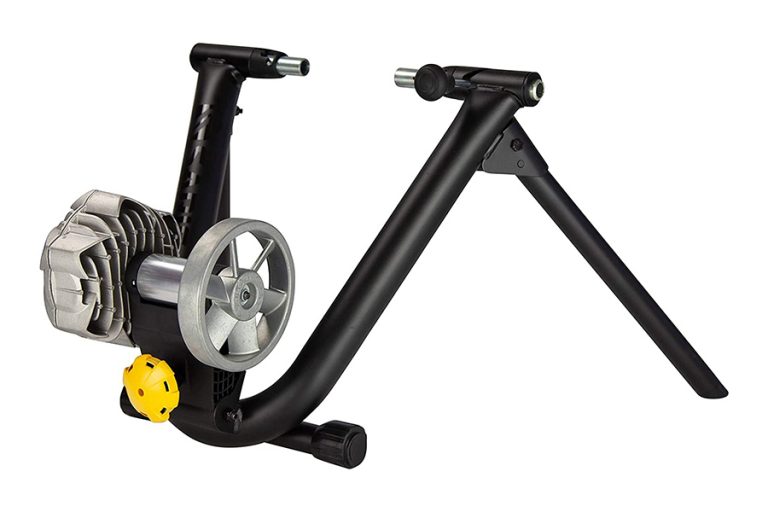
The Saris Fluid 2 interacts with Zwift and TrainerRoad through a speed sensor that is ANT+ and Bluetooth capable.
It relies on the internal fluid to simulate outdoor conditions and resistance. The resistance unit is independent of external or battery power sources making maintenance and repairs a little simpler for the entry-level cyclist.
You won’t aggravate your neighbors even at speeds of up to 20mph, with volume from vibration and mechanical noise kept between 64-68 decibels.
The Saris Fluid2 can also accommodate a wide array of wheel sizes, coming pre-equipped for 120mm, 130mm, and 135mm rear dropout spacing. A 12mm thru-axle adapter can make room for 142mm and 148mm options, as well.
- Pros : Very quiet even at higher power. Easy to mount on.
- Cons : Fluid system will take sometime to warm up.
Budget Trainer Picks
Sometimes called dumb trainers, these definitely won’t break the bank and are ideal especially if you’re just starting out in indoor riding. The features are generally very basic and the resistance is either controlled manually through the resistance knob, or you shifting to a harder gear on your bike.
Sportneer Fluid Trainer and Stand
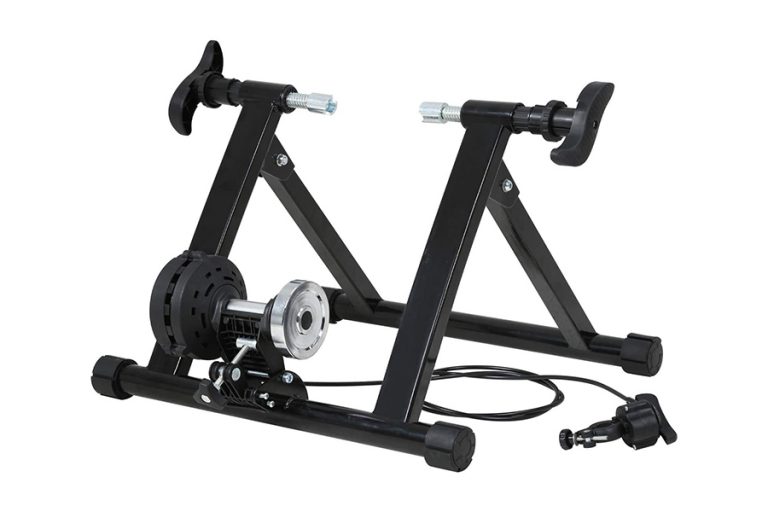
The Sportneer is the best model for beginners because of its ease of use, fluid-based design, and overall modest price. This model will get newbies in the saddle when conditions outside prove unrideable.
It allows users to put maximum power efforts on its smooth fluid system, without compromising resistance. It offers quick release skewers to rapidly mount or dismount a bike with ease and accommodates most road and mountain bikes.
Its small size packs away quickly and makes storage a breeze. This model weighs in at 30-pounds.
- Pros : Cheap. Multiple resistance settings.
- Cons : Prone to tire slippage under load.
Saris Mag
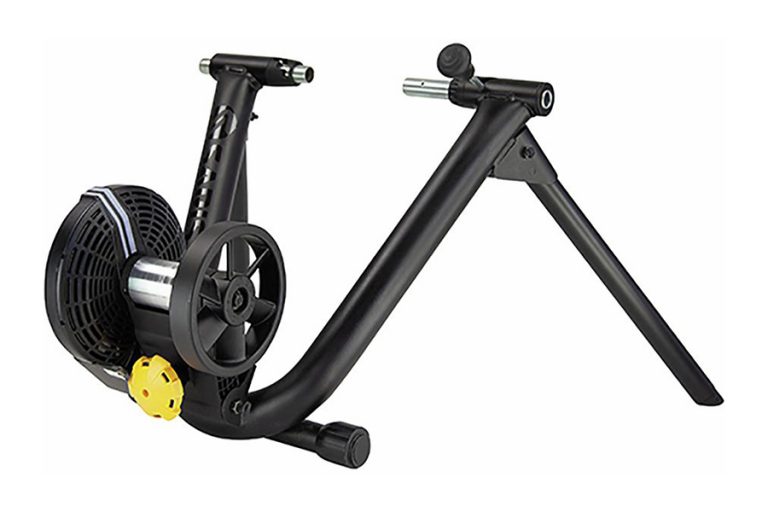
This Saris Mag is probably one of the simplest trainers around.
If you’re looking for a simple, no-frills trainer to improve your performance without having to worry about complicated parts or maintenance, this is for you. It’s compatible with bikes with quick release and 700c, 26″, 27″, and 29″ rear wheel sizes. If you’re using a bike with thru-axles, there’s a separate thru-axle adapter kit available.
All you need to get a separate speed sensor that is ANT+ and Bluetooth capable, connect it to the trainer and your computer.
- Pros : Minimal maintenance needed. Quiet magnetic resistance unit.
- Cons : Initial assembly can be tricky.
Minoura MagRide Q
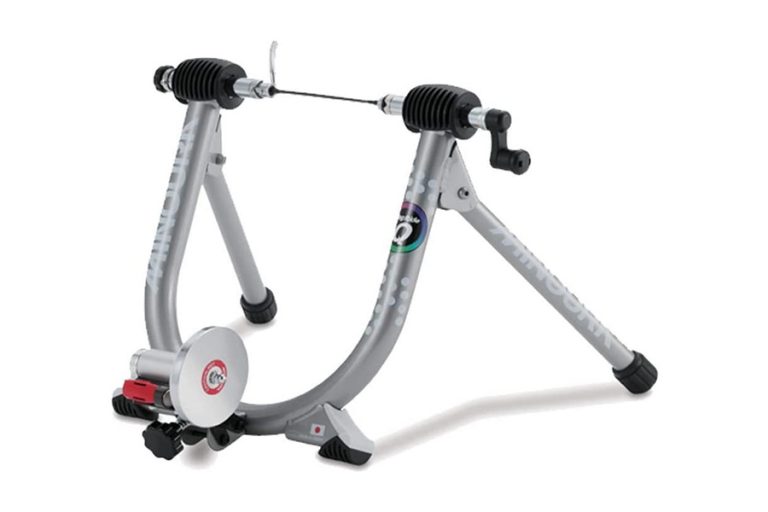
Minoura has been producing bike accessories in their workshop in southern Japan since 1933.
While it might not be well-known like others such as Wahoo or Tacx, you can be sure of a high-quality Japanese product. The MagRide Q has a solid resistance unit which is a 35% improvement over its predecessor. There are 7 manual resistance levels for you to choose from as you ride.
The frame is made of lightweight steel and weighs only 6kg which is ideal if you’ll be constantly moving it around the house.
- Pros : Lightweight and easy to transport. Minimalist design.
- Cons : Resistance unit can be noisy.
Author Recommended Reads

